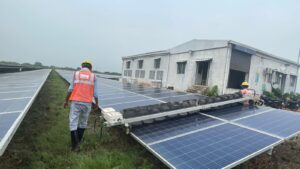
Introduction:
The efficient operation of a solar power plant is contingent on various factors, and one crucial aspect is the cleanliness of photovoltaic (PV) modules. Regular cleaning not only enhances the performance of solar panels but also extends their lifespan. This blog outlines a comprehensive Standard Operating Procedure (SOP) for cleaning solar modules, emphasizing safety precautions, proper scheduling, and meticulous procedures.
Objective:
The purpose of this Standard Operating Procedure (SOP) is to establish a systematic and professional approach to the cleaning of photovoltaic (PV) modules. This practice is essential for maintaining module efficiency, ensuring optimal energy output, and preserving the long-term performance of the solar power plant.
Standard Operating Procedure (SOP) for Photovoltaic (PV) Module Cleaning:
1. Safety First:
Before embarking on any cleaning activity, prioritize safety. Equip yourself with essential protective gear, including gloves and safety glasses, to mitigate potential hazards.
2. Cleaning Schedule:
Developing a tailored cleaning schedule is paramount. Factors such as site location, prevailing weather conditions, and the extent of soiling influence the frequency of cleaning. Creating a schedule aligned with site-specific needs ensures consistent and effective maintenance.
3. Water Quality Matters:
The quality of water used in cleaning directly impacts module performance. To prevent mineral deposits on the glass surface, opt for deionized, reverse osmosis, or rainwater with low mineral content. Total Dissolved Solids (TDS) should ideally be below 30mg/L, ensuring water purity and preventing adverse effects on module efficiency.
4. Cleaning Solutions:
Utilize non-abrasive cleaning solutions specifically designed for solar modules. Adhere to manufacturer instructions for proper dilution. Avoid harsh chemicals that could compromise module integrity.
5. Equipment Preparation:
Before commencing cleaning activities, ensure that all equipment, including brushes, sponges, and squeegees, is meticulously cleaned and free of contaminants. Using metal objects or abrasive products can lead to scratches, adversely affecting module performance.
6. Optimal Cleaning Time:
Choose the right time for cleaning to ensure effectiveness without compromising module integrity. Early mornings, when the plant is not in operation and the temperature of the solar panels is moderate, present an ideal window for cleaning.
7. Water Pressure Considerations:
Exercise caution with water pressure not exceeding 35 bars at the nozzle. High-pressure hoses may cause damage to modules. Striking a balance is crucial to avoid exerting excess pressure.
8. Methodical Module Cleaning:
Follow a systematic approach to module cleaning. Start from the top row and work downwards. Use a soft-bristled brush or sponge to remove loose debris. Wet the surface, apply the cleaning solution, scrub lightly, and conclude with a thorough rinse.
9. Drying Techniques:
After rinsing, use a squeegee or lint-free cloth to eliminate excess water. Allow modules to air dry completely before reconnecting them to the system.
10. Post-Cleaning Inspection:
Once it’s dry, conduct a visual inspection for any damages, cracks, or scratches. Promptly address and rectify any issues observed to ensure optimal module performance.
11. Documentation for Accountability:
Maintain a detailed record of the cleaning schedule, the cleaning solution used, and any damages identified during the process. This documentation serves as a valuable resource for accountability and future reference.
Conclusion:
By adhering to this SOP, you can elevate the efficiency and longevity of your solar modules. Regular, systematic cleaning not only enhances performance but also safeguards your investment in solar energy, contributing to sustainable and reliable power generation.
